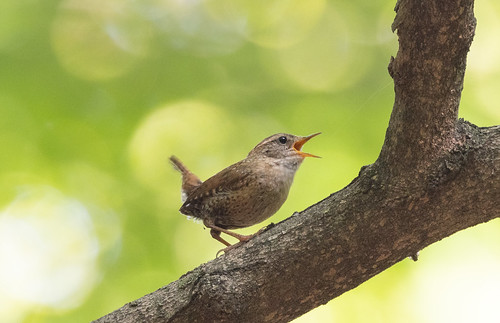 |
| Acadian Flycatcher photo from Wikipedia, public domain. |
I was in Rhinelander, Wisconsin, for the Fourth of July weekend, and got up early that Saturday morning to head to Wausau, to Rib Mountain State Park, to hike along the Homestead Trail.
It was a wonderful hike for seeing birds but not for photographing them—at least, not most of them. A Black-billed Cuckoo flew fairly close, though he stayed in the foliage. A few Wood Thrushes sang away—lovely caroling mostly heard in southeastern hardwood forests than our conifer-dominated North Woods, but they all stayed too far from the trail for photos. A silent Scarlet Tanager alighted on a branch overhead, but flew off before I could pull up my camera.
My target species in that perfect area of the park was the Acadian Flycatcher. Rib Mountain seems to be the farthest north this species extends in Wisconsin—right at the point where hardwood-dominated forest ends; the species doesn’t reach Minnesota except in the extreme southeast. I never thought to look for Acadian Flycatchers in Wausau, but the small population is well enough known to be on the bird checklist for the park, so I’m a little embarrassed that I’d never known it was there.
It was pretty easy to locate at least two—they were singing their explosive little songs from two different directions at a spot where the trail split. And when I walked a quarter of a mile or so further, I heard what was probably a third individual. None of them were close to the trail, and I didn’t want to disturb them by playing a recording to lure them closer.
The Acadian Flycatcher is quite rare in Minnesota, where it’s listed as a Special Concern Species—the DNR designated it a Species of Greatest Conservation Need. There are a handful of reliable locations for it in the state—Beaver Creek Valley State Park, Murphy Hanrehan Regional Park Reserve, and Seven Mile Creek Park. It’s threatened in Wisconsin, but a bit more widespread than in Minnesota, though only in the southern half of the state. Rib Mountain’s habitat is unique for so far north. This species is a useful indicator of forest health because it requires relatively undisturbed hardwood forest. Development sends them packing.
Acadian Flycatchers are one of the species in the genus Empidonax, all of which have an eye-ring and wing-bars—the Acadian’s markings are a little more striking than some of the others, but what clinches identification is the voice. I learned it as pizzAH, but the short, explosive notes are better transcribed as tee-chup or ker-chip. I captured a few songs on my iPhone, but a much, much closer, more cooperative Winter Wren’s persistent singing dominated my recordings—the more distant Acadian Flycatcher sounded like a background singer. That recording is here.
 |
| This persistent little Winter Wren, right in my face, made it hard to record the Acadian Flycatcher! But you can hear the flycatcher a few times in this recording, and also in this one. |
It was thrilling to hear singing Acadian Flycatchers even if I didn’t get any photos. So far, the only photo I’ve ever managed to take of one was a shot from behind, the face not at all visible, which I got in Delaware during my Big Year.
Now that I know where to find them at Rib Mountain State Park fairly easily, I’ll try next year, if they are still there. The City of Wausau and the Wisconsin DNR are considering expanding the Granite Peak Ski Area—a privately owned resort in the park that wants to build ski runs, ski lifts, mountain bike trails, and parking lots right through this unique hardwoods forest, destroying butternut trees and other plant species of special concern in the state and threatening roosts of the threatened Northern Long-eared Bat and Big Brown Bat. You can read about the issue on the Wisconsin Society for Ornithology's website, which also says how to send comments to the DNR before July 14, 2021.
The Acadian Flycatcher is known for requiring undisturbed forest, and this development will directly affect the area where they live in the park. I’m sad that I didn’t even discover this lovely treasure until now, when it is in danger of disappearing forever from that checklist of the birds of Rib Mountain.
 |
 |
| This is just the first page of the checklist, with the key, and the page with the flycatchers. What a rich park this is! |
